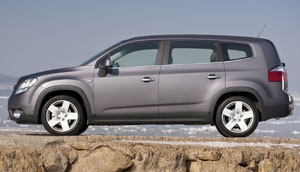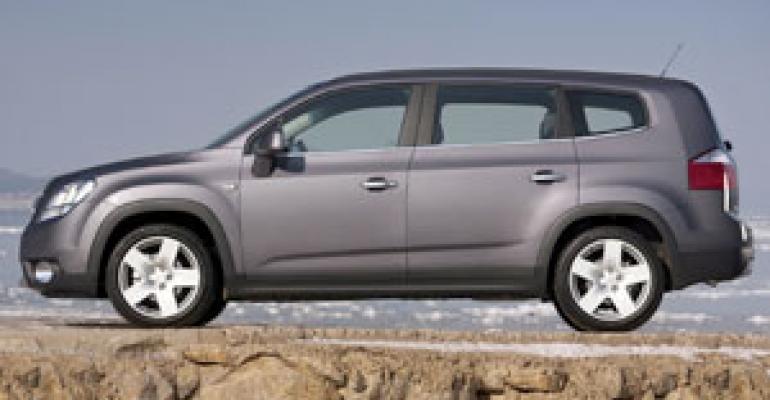
The arrival in Canada of the new-for-’12 Chevrolet Orlando is more proof the northern nation is more closely aligned with the rest of the world than the U.S., its largest trading partner and next-door neighbor.
The 7-passenger cross/utility vehicle arrives next week in Canadian showrooms where smaller vehicles long have been best-sellers. The midsize segment dominates U.S.-market car sales.
“Forever and a day, the top-selling car in Canada is a small car,” says Gregg Cullen, general manager of Ray Cullen Chevrolet in London, ON.
Cullen admits the Orlando is “a little off the beaten path for us,” but says its versatility and price point promise to make it a winner.
“We expect it to do well,” says Cullen, who receives his first units Oct. 3 alongside shipments of the new-for-’12 Chevy Sonic compact car.
Cullen sees young families, or those with older children involved in sports programs, as primary Orlando buyers. GM includes active young professionals and small businesses.
GM also sells the Orlando in Europe, including the U.K., South Korea and South Africa.
Wayne Brannon, head of Chevrolet in Europe, says the Orlando’s recent launch there has exceeded expectations. “Been short of supply all year,” Brannon tells WardsAuto.

Unveiled at the 2009 North American International Auto Show, the Orlando was slated for the U.S. in 2011 with great fanfare.
Gasoline prices had spiked to more than $4 a gallon just six months earlier and the show-car version boasted a 2.0L 4-cyl. diesel engine, promising “excellent fuel efficiency with surprising performance.”
The Orlando’s debut alongside the production-intent Chevy Equinox 5-passenger CUV, Chevy Spark and the recently revived Cadillac Converj extended-range electric vehicle also came as GM lobbied for government and public support ahead of its bankruptcy.
However, GM executives killed the U.S. program before it got off the ground.
One reason: it would create too much overlap in the Chevy portfolio between the 5-passenger Equinox and 8-passenger Traverse CUVs. Both have proved to be runaway hits.
Reports also say the Orlando did not perform well in U.S. customer clinics, one of a number of measurements considered by GM when researching the possibility of bringing a new model to market.
GM spokesman Mike Albano does not elaborate on feedback GM received from those clinics, but size most likely played a role.
Against this backdrop, Ford also killed U.S. plans for a similar 7-passenger CUV called the Grand C-Max because it was seen as too small.
The Orlando features 60/40 split seating for the second row and a 50/50 third-row split. That translates into 16 different seating combinations, GM says, noting the rear cargo area folds flat.
The CUV is powered by GM’s 2.4L direct-injection 4-cyl. Ecotec engine, a Ward’s 10 Best Engines winner. The I-4 mates to a standard-equipment 6-speed manual transmission or optional 6-speed automatic.
They are expected to post fuel-economy ratings are 22-35 mpg (10.1-6.7 L/100 km) 22-35 mpg city/highway and 22-34 mpg (10.6-6.9 L/100 km), respectively – the best fuel economy of any non-hybrid 7-passenger vehicle in Canada, according to GM.
The Orlando’s exterior styling retains much of the look of its progenitor, such as the boxed-off rear end and third-row daylight opening. Lines of the headlamps have been softened and conventional fog lights replace the show car’s light-emitting diode units.
Wheel arches are less pronounced than on the show car and overhangs grow to accommodate the mechanicals of a production model.
Key competitors in Canada include the Mazda 5 and Scion xB in a largely undeveloped segment attracting buyers of small and midsize cars, compact CUVs and vans.
For GM Canada, the Orlando essentially combines the Chevy HHR small CUV and the Pontiac Montana minivan.
The polarizing 5-passenger HHR ended production in Mexico earlier this year, while the Montana, which was sold in Canada for three years after being phased out in the U.S., died only after GM killed the brand in 2009.
The Orlando starts at CA19,995 ($19,439), although GM expects 65% buyers to go for models with a 1LT trim package for CA22,295 ($21,676). Top-of-the-range LTZ models cost CA29,735 ($28,909).
The vehicle is assembled by GM Korea in Gunsan, South Korea. The auto maker also is expected to add a production site in Eastern Europe.
It might be premature to entirely write off the Orlando in the U.S. GM’s recent labor agreement with the United Auto Workers union calls for a new compact vehicle at a to-be-determined plant.
“We’ve been watching (the Orlando) around the world, and the press has been great on the car,” GM’s Albano says. “We will continue to monitor it.”
–with Byron Pope




